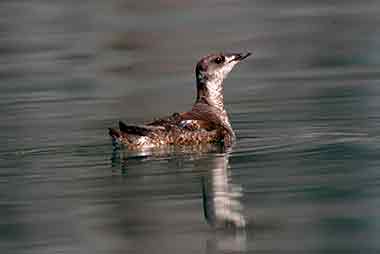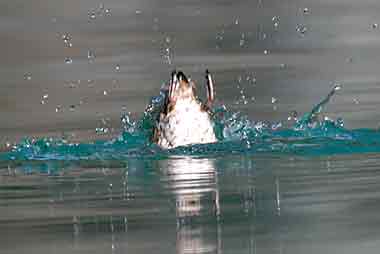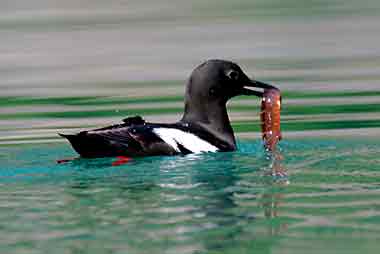| Cloud Ridge Naturalists 2 0 0 6 | ||||
 |
||||
| Thick-billed Murres, photo Audrey Benedict | ||||
| Of Fog Larks & Sea Quail: Seabirds at Risk in a Changing World |
||||
| C O N T E N T S | ||||
|
HOME PAGE / INTRODUCTION 2006 OF TIGER WALLS & CANYON WRENS: A Naturalist's Journey on the Yampa & Green Rivers IMAGES OF WILDERNESS: Glacier Bay & the Inian Islands aboard the MV Catalyst ISLAND WORLDS: Expedition from the Scottish Isles to Iceland aboard the Clipper Adventurer GLACIERS, ISLANDS & FJORDS: An Expedition from Iceland to Greenland aboard the Clipper Adventurer OF FOG LARKS & SEA QUAIL: Sea Birds at Risk in a Changing World |
November 2 – 5, 2006
3 Nights / 4 Days Dr. P. Dee Boersma and Seabird Experts Introducing Our Conservation Workshop Series
Marbled murrelet ,photo Larry Master
Flying fast and low through the dense forest, the parents take turns at making the long commute to foraging areas at sea. Almost nothing was known of the natural history of this fascinating seabird until the first nest was located in 1974, in a grove of California redwoods. More than thirty years later, biologists know enough to be alarmed by the sharp rate of population decline — 70% over the last 20 years in some parts of the species’ range! The marbled murrelet’s story highlights the multiple threats faced by all seabirds. Seabirds live at the mercy of wind and wave — as the sea goes, storm-ridden or serene, so must they. Their survival is inextricably linked to the sea’s many moods, its ecological health, and biological productivity. The unique biology of seabirds — a group of species that includes the gulls, fulmars, auklets, puffins, murrelets, guillemots, murres, petrels, shearwaters, albatrosses, loons, and many species of sea ducks — makes them especially vulnerable to the impacts of global warming, marine pollution, oil spills, declining fish populations, commercial fishing bycatch, habitat loss or degradation, and changes in the rich plankton soup that forms the basis for the entire marine food chain.
Pigeon guillemot , photo Larry Master Our seabird workshop, the first in a special series aboard the classic M/V SeaWolf and co-hosted with Sea Wolf Adventures, our Conservation Partner, will spend three days exploring the San Juan Islands and the region of Samish and Padilla Bays. Many species of seabirds and shorebirds winter in large numbers here, attracted by food-rich tidal rips between the islands and by the highly-productive waters of the estuaries that dot the coast. Dr. Dee Boersma and a team of seabird biologists will join us aboard the M/V SeaWolf for a series of lectures on seabird biology and behavior, as well as on the environmental issues that challenge seabird survival throughout the world. We should have excellent looks at rhinocerous auklets (once called “sea quail”), both marbled and ancient murrelets, common murres, pigeon guillemots, harlequin ducks, scoters, cormorants, and many other species — our observations continually enriched by our onboard experts. Night will find us in a cozy anchorage amongst the islands, continuing our discussions while we savor a fine dinner and a glass of wine. Price: $695 ($100 deposit) Group Size: 12 Price Includes: 3 nights and 4 days aboard the M/V SeaWolf, all meals, staterooms with private facilities, all instruction and instructional materials, and the use of a motorized inflatible. This workshop begins and ends in Bellingham, WA. |
|||
| Contact: | Cloud Ridge Naturalists 8297 Overland Road Ward Colorado 80481 email > cloudridgeadb@earthlink.net |
|||


